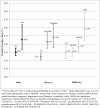An Examination of Claims-based Predictors of Overdose from a Large Medicaid Program
- PMID: 27984346
- PMCID: PMC5309160
- DOI: 10.1097/MLR.0000000000000676
An Examination of Claims-based Predictors of Overdose from a Large Medicaid Program
Abstract
Background: Health systems may play an important role in identification of patients at-risk of opioid medication overdose. However, standard measures for identifying overdose risk in administrative data do not exist.
Objective: Examine the association between opioid medication overdose and 2 validated measures of nonmedical use of prescription opioids within claims data.
Research design: A longitudinal retrospective cohort study that estimated associations between overdose and nonmedical use.
Subjects: Adult Pennsylvania Medicaid program 2007-2012 patients initiating opioid treatment who were: nondual eligible, without cancer diagnosis, and not in long-term care facilities or receiving hospice.
Measures: Overdose (International Classification of Disease, ninth edition, prescription opioid poisonings codes), opioid abuse (opioid use disorder diagnosis while possessing an opioid prescription), opioid misuse (a composite indicator of number of opioid prescribers, number of pharmacies, and days supplied), and dose exposure during opioid treatment episodes.
Results: A total of 372,347 Medicaid enrollees with 583,013 new opioid treatment episodes were included in the cohort. Opioid overdose was higher among those with abuse (1.5%) compared with those without (0.2%, P<0.001). Overdose was higher among those with probable (1.8%) and possible (0.9%) misuse compared with those without (0.2%, P<0.001). Abuse [adjusted rate ratio (ARR), 1.52; 95% confidence interval (CI), 1.10-2.10), probable misuse (ARR, 1.98; 95% CI, 1.46-2.67), and possible misuse (ARR, 1.76; 95% CI, 1.48-2.09) were associated with significantly more events of opioid medication overdose compared with those without.
Conclusions: Claims-based measures can be used by health systems to identify individuals at-risk of overdose who can be targeted for restrictions on opioid prescribing, dispensing, or referral to treatment.
Figures


References
-
- Rudd R, Aleshire N, Zibbell J, Gladden M. Increases in Drug and Opioid Overdose Deaths — United States, 2000–2014. Centers for Disease Control and Prevention; Atlanta, GA: 2015.
-
- Centers for Disease Control and Prevention [July 16, 2015];Prescription Drug Overdose Data: Deaths from Prescription Opioid Overdose. 2015 http://www.cdc.gov/drugoverdose/data/overdose.html.
-
- White House . Obama Administration Announces Public and Private Sector Efforts to Address Prescription Drug Abuse and Heroin Use [press release] Office of the Press Secretary; Washington DC: 2015.
-
- Logan J, Liu Y, Paulozzi L, Zhang K, Jones C. Opioid prescribing in emergency departments: the prevalence of potentially inappropriate prescribing and misuse. Med Care. 2013;51:646–653. - PubMed
Publication types
MeSH terms
Substances
Grants and funding
LinkOut - more resources
Full Text Sources
Other Literature Sources
Medical
Molecular Biology Databases

